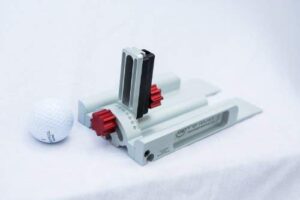Stryper SwingMate Review: The Training Aid That Demands More Than Your Credit Card
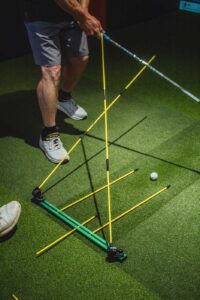
Birdie Score
Price
$134
One-Putt Summary
The SwingMate is a precision practice tool disguised as a consumer product—exceptional for disciplined mid-handicappers with coaching access, overwhelming for casual golfers seeking plug-and-play simplicity.
Fairways (Pros)
- ✓ Exceptional build quality that justifies premium positioning
- ✓ Genuine coaching endorsements from tour-level instructors
- ✓ Complete kit advantage over competitors
- ✓ Solves the mat-practice problem
Hazards (Cons)
- ✗ Steep learning curve creates abandonware risk
- ✗ International shipping and availability friction
- ✗ Overwhelming to look at
Best For
Mid-handicappers with persistent path issues who practice on mats or simulators with access to coaches
Stryper SwingMate Review: The Training Aid That Demands More Than Your Credit Card
I’ll be straight with you: the Stryper SwingMate isn’t for golfers who want a magic wand. It’s for golfers who want a hammer—something sturdy, precise, and effective when wielded properly, but capable of building nothing in the hands of someone who doesn’t know construction.
After analyzing dozens of professional coaching sessions, user reports, and comparative tests, here’s what you need to know before dropping ~$115-120 USD on this Australian-made training system.
Key Takeaways
The SwingMate delivers genuine swing path correction when used deliberately—but it’s a coach’s tool disguised as a consumer product. Mid-handicappers (10-20) with persistent slice/hook issues and coaching access will see measurable improvement. Casual weekend warriors seeking quick fixes should save their money for alignment sticks and a bucket.
✓ Best for:
Dedicated golfers who practice on mats/simulators 2-3x weekly and understand constraint-based learning
✗ Skip if:
You’re a beginner without coaching access, prefer grass-only practice, or want plug-and-play simplicity
What Is the Stryper SwingMate?
The SwingMate is a multi-axis alignment rod holder system engineered specifically for golfers practicing on surfaces where traditional sticks can’t be staked into the ground—think indoor simulators, garage nets, and artificial turf driving ranges.
The core innovation: Spring-loaded ratcheting hinges with printed 10-degree angle markers that lock alignment rods into precise, repeatable positions. Unlike jamming sticks into an upside-down bucket, the SwingMate’s CNC-machined aluminum base and adjustable hinges create a stable gate system for swing plane drills that you can replicate identically across practice sessions.
What’s in the box:
- • CNC-machined anodized aluminum base plate (0.93kg)
- • 2 proprietary ratcheting rod holder hinges
- • 5 fiberglass alignment rods (400mm, two 600mm, 1.2m foldable, 1.6m four-piece)
- • 1680D ballistic nylon carry bag
Total weight: 1.7kg; packs down to 65cm x 6cm x 7cm
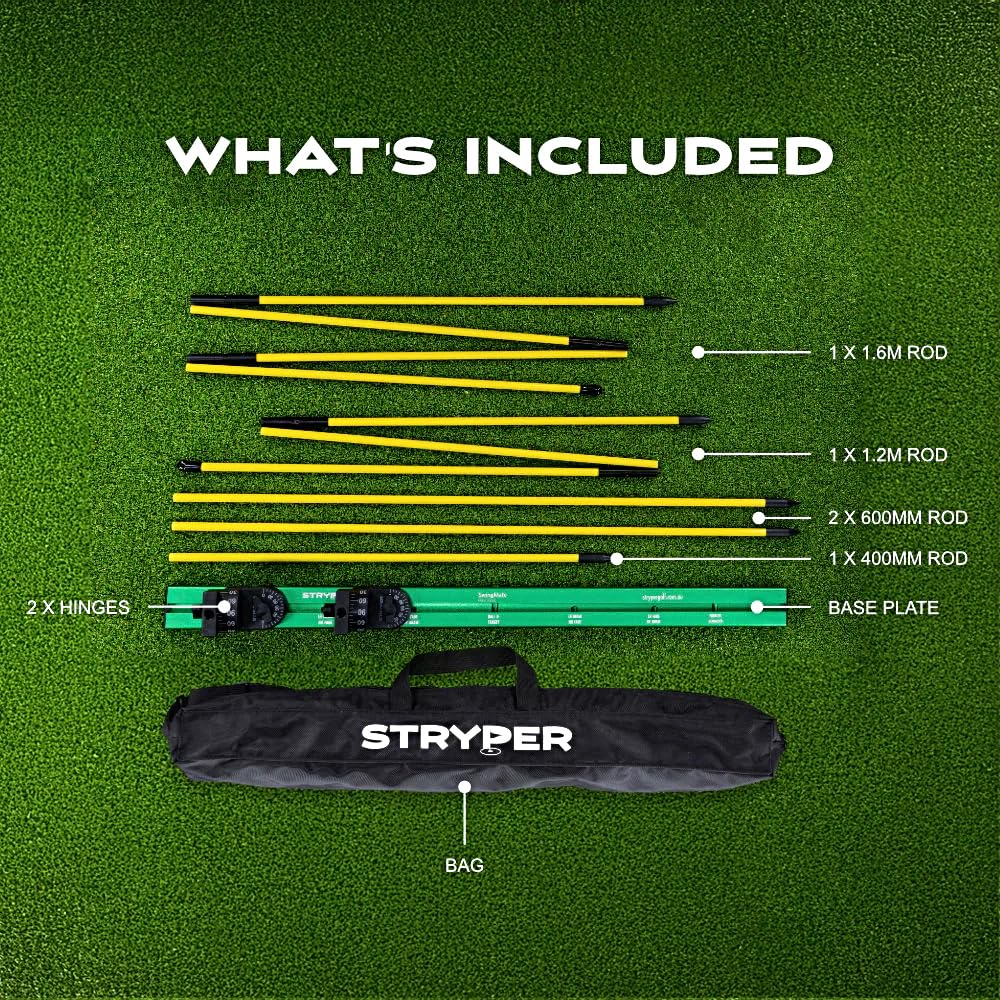
The manufacturer’s claim: This system corrects swing plane, club path, hand path, rotation issues, and low-point control through visual feedback and constraint-based learning. The adjustability enables everything from basic slice-fixing gates to complex multi-rod drills addressing simultaneous swing faults.
Build Quality & Durability: Tank-Level Construction
This is where the SwingMate earns its premium positioning. The CNC-machined aluminum base isn’t decorative—it’s genuinely overbuilt in the best possible way. Aussie Golf Reviewer Richo stress-tested the unit by intentionally “clobbering” alignment rods at full speed. Result? Zero damage to the device or clubs.
The spring-loaded ratchet mechanisms feel substantial, not flimsy. After reviewing extensive forum discussions and user reports, I found exactly zero complaints about hinges breaking, base plates cracking, or rods shattering. For a training aid designed to withstand club contact, that’s remarkable.
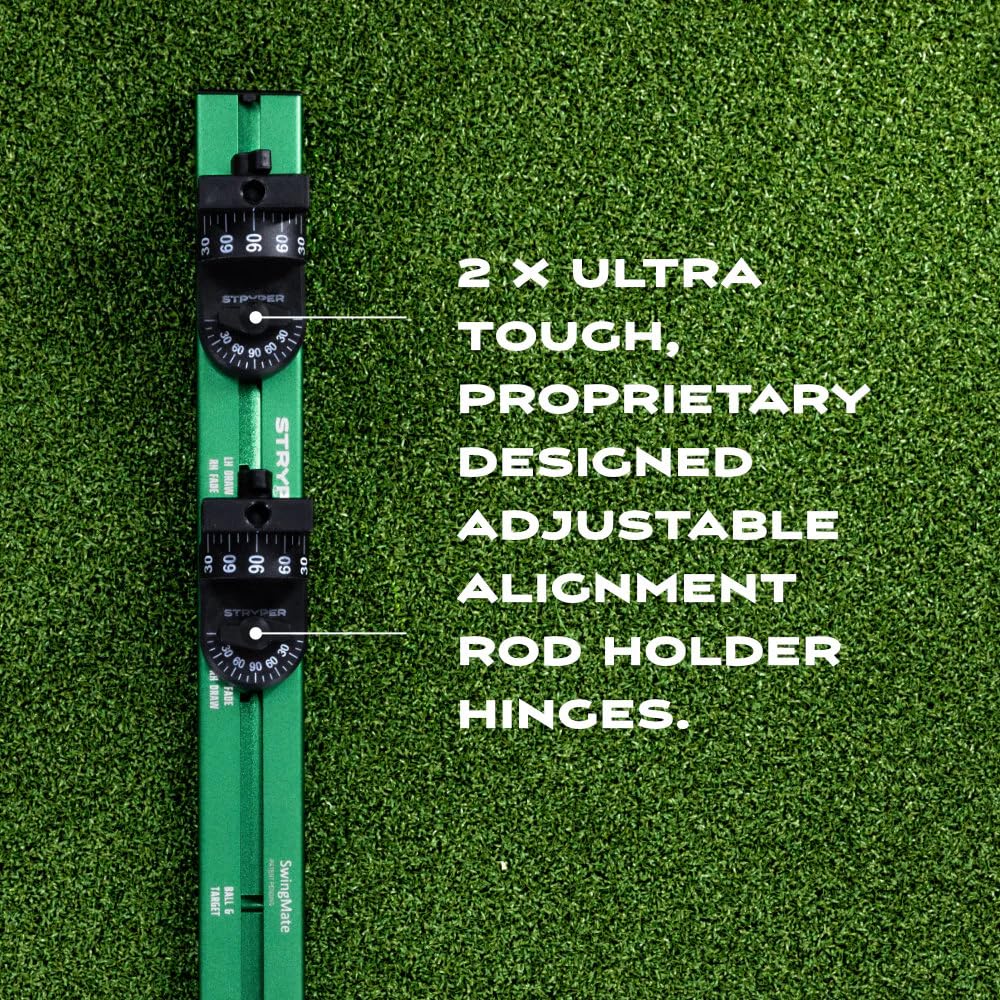
Durability Highlight
The fiberglass rods deserve specific mention—the included 1.6m four-piece rod breaks down for safer full-swing work in confined spaces, addressing a legitimate safety concern competitors ignore.
Minor caveat: The t-nut sliding system and ratchet locks require decent finger dexterity. Users with arthritis or hand mobility issues may find adjustments fiddly, though no one specifically complained about this in my research.
Build Quality & Durability Score
Exceptional materials; zero breakage reports
19/20
Effectiveness: The Coaching Multiplier Effect
Here’s where things get nuanced. The SwingMate works—but with critical caveats that separate satisfied users from frustrated ones.
What the Data Shows
Measurable Results
PGA Coach Marcus McPherson documented a 5-handicap golfer achieving a 4-degree club path correction in a single session, shifting from an inside-out hook pattern to neutral. That’s not marketing fluff—that’s measurable on-camera improvement captured during independent coaching.
Grant Field, tour coach to PGA winner Cameron Smith, called it a tool that “will become a big part of my coaching tool box…might just become one of my new favourites.” When a tour-level coach endorses something unprompted, that carries weight.
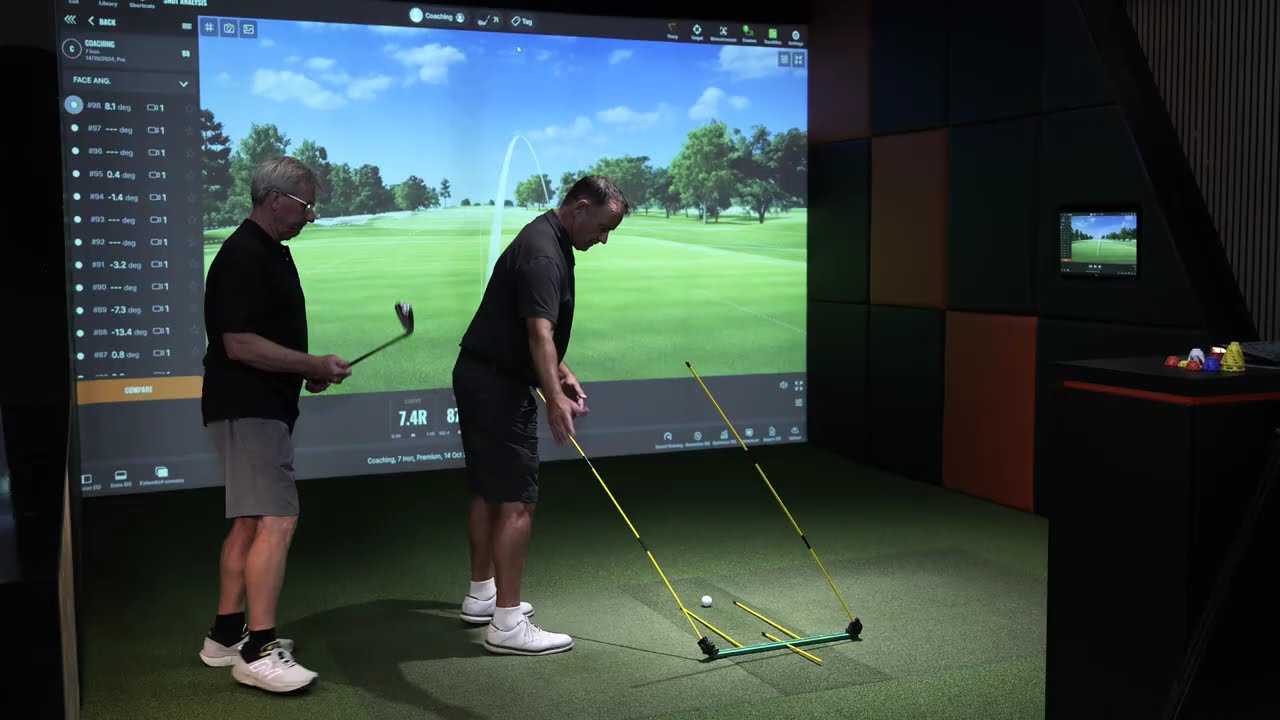
The Catch: It’s a Coach’s Tool
Aussie Golf Reviewer Al Staines nailed the limitation:
“Do I think it’s for everybody? I’d probably say no. Is it for coaches? I could see a lot more coaches using this.”
The problem for solo practitioners: The SwingMate’s versatility creates overwhelm. Users struggle to know which angles to set, which drills to prioritize, and how to sequence their practice. One Reddit user captured it perfectly: “There’s so many different things that this can be done or used for”—that’s both the product’s strength and its accessibility barrier.
The transfer challenge: Like all training aids, the SwingMate faces the universal problem of aided practice not automatically translating to unaided rounds. A Reddit golfer articulated: “I feel caught between my old swing and the new technique…I’m worried that without the training aid, my swing will revert.”
Success pattern:
Users achieving lasting results consistently mentioned:
- • Alternating 1-3 swings with the aid, then 1-3 without, to transfer the feel
- • Using it every third practice session for maintenance (not constant dependence)
- • Pairing it with video analysis or coaching to understand why the change matters
What It Actually Fixes


✓ Primary sweet spot:
Over-the-top swing paths causing slices. Multiple users and coaches confirmed immediate awareness when rods provided physical feedback for outside-in paths.
Also effective for:
- • Hook correction (by setting fade-bias gates)
- • Limited hip rotation (using the thigh alignment rod drill)
- • Poor hand path (preventing casting or getting stuck)
- • Inconsistent low-point control
✗ Won’t fix:
- ✗ Grip issues
- ✗ Setup fundamentals
- ✗ Weight transfer patterns
- ✗ Face control
The SwingMate shows where the club should be, not how to get there.
Effectiveness Score
Real results with coaching; transfer challenges without
25/30
Ease of Use: The Intimidation Factor
This is the SwingMate’s biggest weakness, and it’s not about the physical hardware.
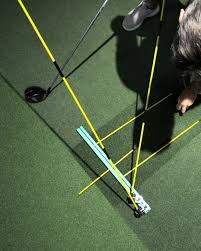
Initial setup: 5-10 minutes to understand hinge adjustments, angle markings, and rod placement. Experienced users reduce this to 2-3 minutes once familiar.
The learning curve isn’t intuitive. While Stryper provides key drills on their website, users noted a lack of comprehensive video tutorials for all possible configurations. Most learning happens through trial-and-error or—critically—coaching sessions that incorporate the tool.
The intimidation factor is real
Even confident ball-strikers admitted feeling “a little bit worried hitting a full shot” with rods positioned near the swing path. That psychological hesitation can hinder natural tempo until you acclimate.
Usage Notes
Pre-round warmup suitability: Not practical. This demands dedicated 30+ minute practice sessions, not rushed tee-side preparation.
Comfort issues: Zero reported instances of pain, injury, or club damage in extensive forum searches. The manufacturer correctly notes the base sits “half a metre away from the low-point” of the swing, so you’d need to be wildly off-line to strike aluminum.
Ease of Use Score
Steep learning curve; intimidation factor
12/20
Value for Money: The DIY Debate
At ~$115-120 USD delivered (AUD $159 in Australia), the SwingMate sits in uncomfortable middle ground.
What you’re paying for:
- • Precision engineering (spring-loaded ratchets, calibrated 10-degree increments)
- • Complete system (5 rods + carry bag vs. competitors selling rods separately)
- • Superior adjustability vs. fixed-slot alternatives
The comparison math:
| DIY bucket + alignment sticks | $15-20 (mimics basic gates but lacks precision/repeatability) |
| Blue Brick | $169 USD with rods (fixed slots, less adjustable, but simpler) |
| Pathpal Golf | $90 (splits in half, putting drills incorporated) |
| Swing Plane Perfector | $350+ USD (premium positioning, less versatile) |
| SwingMate | $115-120 USD with everything (middle tier, maximum flexibility) |
Reddit user consensus captured the resistance:
“They are plastic with a few holes at various angles…if a company could produce a quality product at a reasonable price, I believe it would fly off the shelves.”
That critique misses the CNC machining, spring mechanisms, and engineering—but it reflects real market perception.
For casual golfers satisfied with basic alignment work, $115 feels steep. For committed practitioners who will exploit the full adjustability range, it’s reasonable value.
Shipping note: Free over AU$100 in Australia/NZ. International buyers pay $24 USD or €20 EUR—not prohibitive but worth factoring.
Value for Money Score
Fair price vs. competitors; expensive vs. DIY
18/25
Versatility: The Swiss Army Knife Paradox
The SwingMate’s adjustability is genuinely impressive. Multi-axis ratcheting (vertical inclination, horizontal spin, sliding base position) enables:
• Basic draw/fade path gates
• Complex multi-rod rotation drills
• Hand path constraints
• Low-point training setups
• Post-impact exit path feedback
One coach competition even joked about a “Hold My Beer” drill challenge due to limitless configuration possibilities.
The paradox:
This versatility makes it powerful for coaches and overwhelming for consumers. It’s a Swiss Army knife when many golfers just need a good chef’s knife.
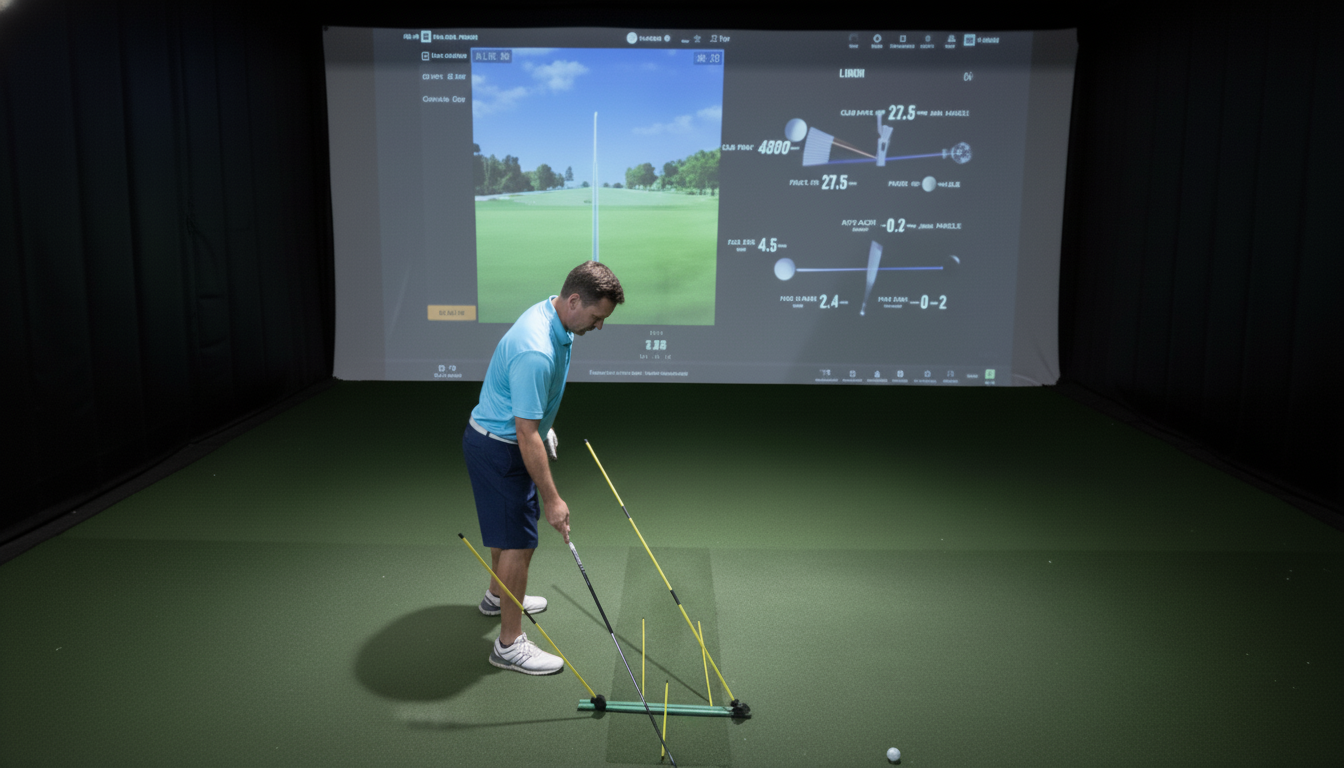
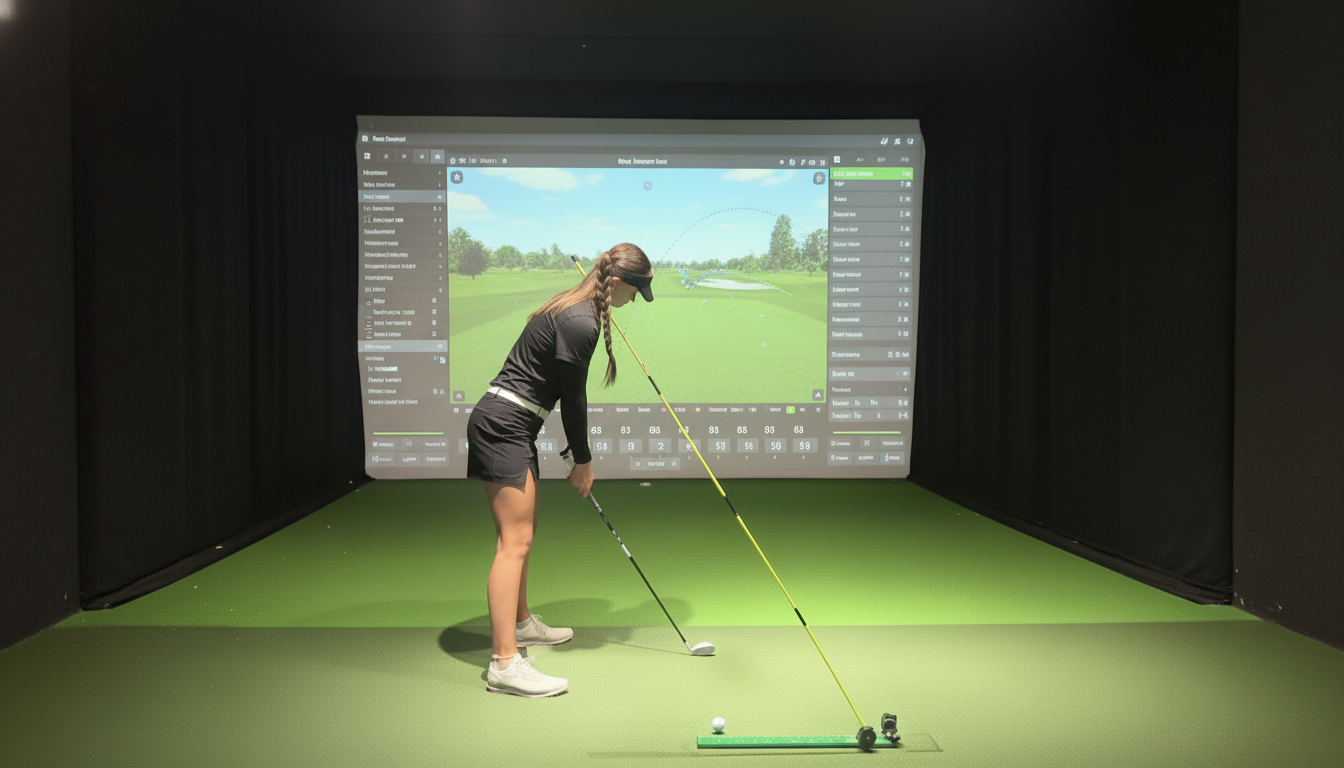
Versatility Score
Multi-drill capability; complexity trades simplicity
5/5
Performance Score Breakdown
Who This Is Actually For
Best For:
The committed mid-handicapper (10-20) with:
- ✓ Persistent slice/hook from path issues despite “knowing” the fix
- ✓ Access to coaching or strong self-analysis ability (video review)
- ✓ 2-3 weekly practice sessions of 30+ minutes
- ✓ Mat/simulator practice environment (home setup or indoor facility)
- ✓ Understanding of constraint-based learning principles
Teaching professionals: Grant Field’s endorsement reflects genuine coaching utility—instant student feedback and repeatable drill stations justify the investment.
Low handicappers (5-9) maintaining fundamentals: Periodic reinforcement between lessons rather than learning new patterns.
Skip If You’re:
- ✗ Absolute beginner (25+ handicap): Lacks foundational understanding to interpret feedback or select appropriate drills
- ✗ Casual weekend warrior: Won’t commit to structured practice routines required to justify $115
- ✗ Grass-range-only practitioner: The “practice anywhere” benefit doesn’t apply
- ✗ DIY enthusiast: Capable of drilling PVC pipe at angles or improvising with buckets
- ✗ Seeking instant on-course fixes: Training aids require range repetition to internalize changes
The Alternatives: What Else Should You Consider?
If the SwingMate feels like overkill:
Alignment sticks + bucket ($15-20)
Reddit’s most-recommended budget solution. Jam sticks into an upside-down range bucket for basic gate drills. You lose precision, repeatability, and multi-rod capability, but you keep $100.
Pathpal ($90)
Fixed slots (14 preset angles) eliminate adjustment complexity. Greater versatile when you consider the split design and putting functionality, and simpler for golfers wanting prescriptive guidance rather than infinite options.
Orange Whip or similar tempo trainers ($100-150)
If your issue is tempo/rhythm rather than path, these deliver better targeted value.
Private lesson ($75-150)
One hour with a teaching pro identifying your actual swing fault might prevent buying the wrong training aid entirely.
FAQ
Will this fix my slice permanently?
Can I use this at a grass driving range?
How long until I see results?
Does it work for left-handed golfers?
Will it damage my clubs?
Can beginners use this?
What if I set it up wrong?
How does it compare to the Plane Truth system or Tour Striker Smart Ball?
Is it worth it for simulator-only golfers?
Can I buy just the hinges and use my own rods?
Fairways & Hazards
Fairways (Strengths)
- ✓ Exceptional build quality that justifies premium positioning – CNC-machined aluminum and spring-loaded mechanisms withstand full-speed contact without damage. This isn’t plastic junk.
- ✓ Genuine coaching endorsements from tour-level instructors – Grant Field (Cameron Smith’s coach) and Marcus McPherson use it in actual lessons, not just paid promotions.
- ✓ Complete kit advantage over competitors – Five rods plus carry bag included. Blue Brick charges $130 then makes you buy rods separately. You’re ready to practice out of the box.
- ✓ Solves the mat-practice problem – Indoor simulator golfers and artificial turf users finally have a stable, repeatable drill system without improvising buckets or PVC contraptions.
- ✓ Measurable path correction in skilled hands – Documented 4-degree club path shifts in single sessions when used with proper instruction and deliberate practice.
Hazards (Limitations)
- ⚠ Steep learning curve creates abandonware risk – If you’re a mid-handicapper without coaching access, the overwhelming adjustability may leave this gathering dust after the initial excitement wears off.
- ⚠ Transfer to course play requires disciplined transitional practice – The aided-practice-to-unaided-rounds gap trips up most training aid users. SwingMate doesn’t fix this universal challenge.
- ⚠ International shipping and availability friction – Australian brand not stocked by US/UK major retailers means $24 USD shipping and potential customs delays.
- ⚠ Price resistance from DIY-capable golfers – At $115, you’re paying for precision engineering that bucket-and-sticks methods can’t replicate. But if you’re handy and understand angles, you’ll question the value.
One-Putt Summary
The SwingMate is a precision practice tool disguised as a consumer product—exceptional for disciplined mid-handicappers with coaching access, overwhelming for casual golfers seeking plug-and-play simplicity.
The Bottom Line
The Stryper SwingMate earns its 78/100 rating because it’s honest about what it is: a sophisticated practice tool that rewards deliberate effort, not a magic bullet for the masses.
If you’re a 10-20 handicapper who practices on mats or in a simulator 2-3 times weekly, understands your swing fault, and works with a coach (or has strong self-awareness through video analysis), the SwingMate delivers measurable path correction. The exceptional build quality and complete kit make it competitive value against alternatives like the Blue Brick.
But if you’re expecting to unwrap this, set it up once, and permanently fix your slice, prepare for disappointment. The device’s effectiveness ceiling is directly proportional to your practice discipline and understanding of swing mechanics.
My recommendation:
If you fit the ideal user profile and can budget for a lesson to dial in your setup, buy it. The combination of durability, adjustability, and proven coaching utility justifies the investment for the right golfer. If you’re unsure whether you’ll commit to structured practice, start with $15 alignment sticks and a bucket. If you use those consistently for a month, you’ve earned the upgrade.
The SwingMate doesn’t demand just your credit card—it demands your time, focus, and commitment to improvement. If you’re ready to meet it halfway, it won’t let you down.
⛳ The 19th Hole: Final Verdict
The SwingMate is a precision practice tool disguised as a consumer product—exceptional for disciplined mid-handicappers with coaching access, overwhelming for casual golfers seeking plug-and-play simplicity.
Birdie Score: 76/100


